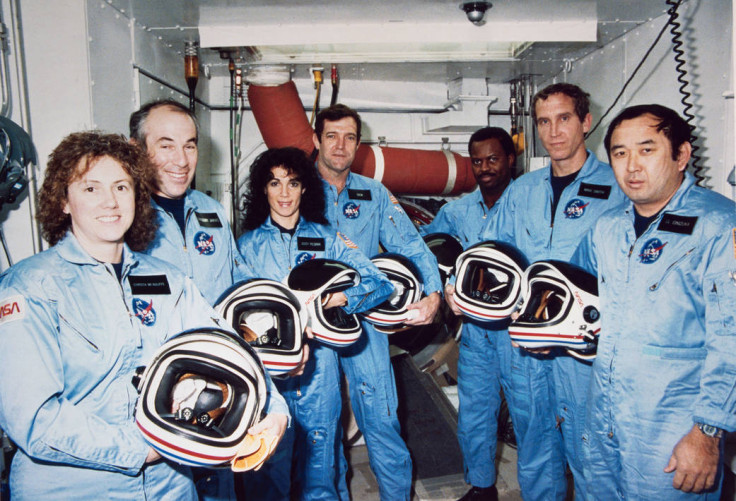Challenger disaster: Nasa pays tribute to mission crew on 30th anniversary of fatal explosion

Nasa is set to host a Day of Remembrance on the 30th anniversary of the Challenger disaster, paying tribute to the crew of the fatal mission, along with those of the Apollo 1 and Columbia space shuttles. A wreath-laying ceremony will begin at 11am EST (4pm GMT) at the Space Mirror Memorial at the Kennedy Space Center Visitor Complex in Florida, which can be watched online herefrom 10am EST (3pm GMT).
"The observance is hosted by the Astronauts Memorial Foundation, which is a private, not-for-profit organisation," Nasa said in a statement. "It built and maintains the Space Mirror Memorial, which was dedicated in 1991 to honour all astronauts who lost their lives on missions or during training. It has been designated a National Memorial by Congress."
Challenger mission
Challenger was the second orbiter of the Nasa's space shuttle programme, after Columbia. There had been nine successful launches an landing before STS-51-L, which was scheduled to deploy tracking and data relay satellites, carry out the first flight of SPARTAN-203 to observe Halley's comet and carry out a number of lessons from space as part of a special Teacher in Space programme.
When did the space shuttle blow up?
On 28 January, 1986, Challenger took off from the Kennedy Space Centre. However, just 73 seconds after launch, it exploded. It later emerged that a seal on the side of the Solid Rocket Booster had failed. All seven crew were killed.
It is estimated that 17% of the population of the US watched the live launch. Following the disaster, then-US president Ronald Regan addressed the nation with a speech: "For the families of the seven, we cannot bear, as you do, the full impact of this tragedy. But we feel the loss, and we're thinking about you so very much. Your loved ones were daring and brave... we've grown used to the idea of space, and perhaps we forget that we've only just begun. We're still pioneers. They, the members of the Challenger crew, were pioneers.
"And I want to say something to the schoolchildren of America who were watching the live coverage of the shuttle's take-off. I know it is hard to understand, but sometimes painful things like this happen. It's all part of the process of exploration and discovery. It's all part of taking a chance and expanding man's horizons. The future doesn't belong to the fainthearted – it belongs to the brave. The Challenger crew was pulling us into the future, and we'll continue to follow them."
Who were the crew of the Challenger?
The Challenger crew were mission commander Francis R Scobee, pilot Michal J Smith, mission specialists Judith A Resnik, Ronald E McNair and Ellison S Onizuka, payload specials Gregory B Jarvis and Teacher-in-Space payload specialist Sharon Christa McAuliffe. McAuliffe had been chosen from 11,000 teachers who had applied to fly on the challenger mission. Smith was the last to be heard from over the crew's voice recorder. He was heard saying "Uh-ho" just before data from the shuttle was lost.
What caused the explosion?
A seal – called an 'O-ring' – on Challenger's right rocket booster had failed during lift-off. This meant that hot pressurised gas was escaping from inside the booster, vaporising the material that connected the rocket booster to the shuttle's tank. Both pieces of the shuttle broke up as a result. On the day of the launch, it was very cold – the mission had been delayed several times because of poor conditions prior to this. It was later concluded the cold weather had contributed to the failure of the O-ring.
How did the crew die and what happened to the space shuttle?
The space shuttle itself broke apart in a ball of flames. The crew module separated and dropped 50,000 feet into the sea – a freefall that took around 2.5 minutes. There were no parachutes and no way for the astronauts to jettison the hatch – had they survived the explosion.
The precise timing of the crew's death is not known, but it is believed they died from the shock of the blast. Had any of the crew survived the initial break-up of Challenger, none could survive the impact of the crew module hitting the Atlantic Ocean. Fragments of the orbiter were recovered off the coast of central Florida. Divers recovered the cabin a few months later, finding the remains of the astronauts inside, but none were recognisable. The shuttle was crushed when it hit the water due to the huge impact.
What happened in the aftermath?
After the disaster, the shuttle programme was suspended for 32 months. The Rogers Commission report into the disaster resulted in nine recommendations that Nasa needed to make to improve safety. Space flights resumed in 1988 with the Discovery's STS-26 mission. The next time the space agency would see a similar disaster was on 1 February 2003, when the Columbia space shuttle broke up on re-entry into Earth's atmosphere – and all seven crew members were killed.
© Copyright IBTimes 2025. All rights reserved.






















